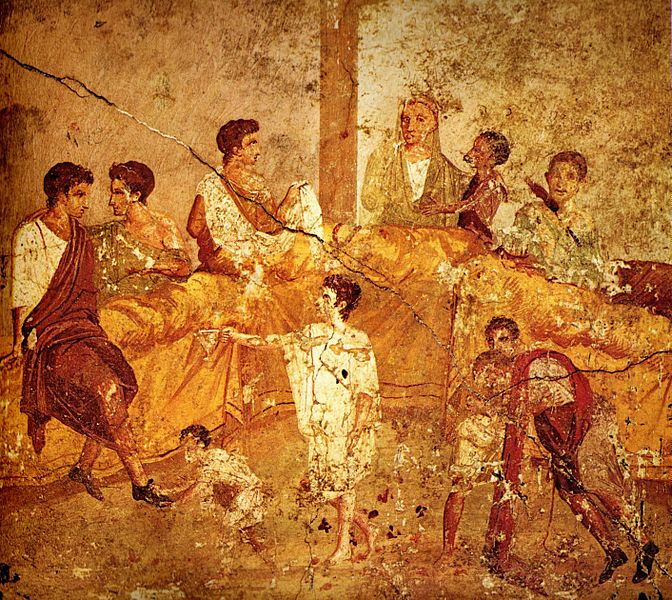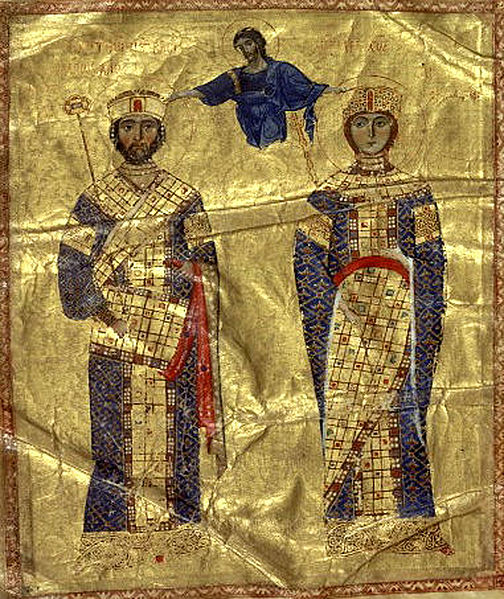A type of toga worn by an elite few in Ancient Rome and the Byzantine Empire that was richly embroidered, patterned and dyed solid purple.
The Details
Phyllis Tortora in The Berg Companion to Fashion (2010) describes the toga picta:
“A toga picta was purple with gold embroidery. Victorious generals and others who had been singled out for special honors were awarded the opportunity to wear this toga.”
A toga picta was also worn by an Etruscan aristocrat, Vel Saties, as shown in figure 1. The Etruscans, who were defeated by the Romans, initiated this type of formal wear. According to Jaclyn Neel in “The François Tomb,” only superior aristocrats like Vel Saties, who commissioned the François Tomb, were able to wear the toga picta. The toga picta was mainly worn by victorious generals and emperors for ceremonies celebrating military victories. In the left corner of figure 2, a male figure is wearing the toga picta for a celebratory feast in a wall painting from Pompeii.
Fig. 1 - Unknown. Portrait of Vel Saties, atrium of the François Tomb, Vulci (Villa Albani, Rome), 4th century B.C.E. Fresco on wall; 150 cm: depth of the tomb room (590.551 in: depth of the tomb room). Rome: Villa Albani, Private Collection. Discoverers, Alessandro François and Adolphe Noël des Vergers. Source: Municipality of Montalto Di Castro
Fig. 2 - Unknown (Italian). Pompeii Family Feast, Before 79 AD. Fresco; 68 x 66 cm (26.7717 x 25.9843 in). Naples: Museo Archeologico Nazionale, inv. Nr. 120029. From IV Pompeian stile. Source: Wikimedia Commons
The fact that the toga picta was worn by Ancient Roman generals and emperors is further explored in A History of Fashion (1980) by J. Anderson Black and Madge Garland. Black and Garland state that toga picta was:
“a triumphal garment worn with the tunica palmata by generals after victorious campaigns. These were the property of the state and were lent to the generals for special ceremonies. Like the tunica palmata, the toga picta was decorated with a purple background embroidered with gold thread. Later it became the official robe of the emperor and was retained for his exclusive use.” (42)
According to Mary G. Houston in Ancient Greek, Roman & Byzantine Costumes (2012), the toga picta was:
“worn by victorious generals, emperors, and later, by consuls.” (92)
Togas started to lose their popularity with Roman citizens, but ceremonial togas like the toga picta were an exception (Houston 92). Other forms of highly ornamented dress became popular, which were often worn not only by the generals and emperors, but also by the consuls (Fig. 3). Figure 3 is a diptych of consul Flavius Felix wearing the tunica palmata, mentioned above, which constituted part of the “Ornamenta Triumphalis” along with toga picta (Guhl and Koner).
Mary G. Houston further writes about the toga picta in Ancient Greek, Roman & Byzantine Costume (2012):
“At the commencement of the second century A.D. the toga was going out of fashion as the ordinary dress of a Roman citizen, but as a ceremonial costume it was retained, and as late as the fifth century A.D. we find it worn by Roman consuls and highly ornamented (toga picta). The dimensions of this toga are longer and narrower than that of the Republican Era, though the shape is similar except that an eight-inch ornamental band was probably sewn to the straight edge.” (92-93)
Fig. 3 - Unknown (Italy, Lazio, Rome). Flavius Felix Consular Diptych Sheet, 428 A.D. Elephant ivory; 29.3 x 13.6 cm (11.53543 x 5.354331 in). Paris: Cabinet des Médailles, Inv.55.295. Mr Roulhac Rochebrune, 1808. Source: Wikimedia Commons
Fig. 4 - Unknown. Christ blesses the emperor Constantin VII Porphyrogenetus, 945 AD. Ivory. Moscow: Pushkin Museum of Fine Arts, P-162. Purchased by Count Uvarov in Echmiadzin, Armenia 19. Source: Pushkin Museum of Fine Arts
Fig. 5 - Unknown. Christ Crowning Michael VII Doukas (relabeled Nikephoros III Botaneiates) and Maria of Alania, between 1074 and 1081. Manuscript illustration. Paris: Bibliothèque nationale de France. Manuscript Coislin 79 folio 2 bis verso. Illustration from the Homilies of John Chrysostom. Evans, Helen C. and William D. Wixom, ed.. Source: Wikimedia
The Byzantine “loros” was derived from the decorated band of the toga picta (Fig. 4). In the Dress, Law and Naked Truth: A Cultural Study of Fashion and Form (2013), Gary Watt writes that:
“the Byzantine loros (or lorum), that was derived from the decorated toga picta worn by Roman consuls, was a long embroidered scarf which, like the toga, was worn draped and wrapped in an orderly fashion.” (35)
Figure 4 shows Constantine VII in the Byzantine loros, a long, narrow and embroidered scarf, while receiving a blessing from Christ. Figure 5 also portrays the Byzantine loros, clearly embellished in gold, worn by Manouel I Komnenos.
References:
- Black, J. Anderson, Madge Garland, and Frances Kennett. A History of Fashion. Rev. ed. New York: Quill, 1980. http://www.worldcat.org/oclc/26606290.
- “Diptych, ‘Flavius Felix Consular Diptych Sheet.’” Medailles et antiques. Accessed October 9, 2018. http://medaillesetantiques.bnf.fr/ark:/12148/c33gbf9f0.
- Guhl, E, W Koner, and Francis Hueffer. The Life of the Greeks and Romans, Described from Antique Monuments: By E. Guhl and W. Koner. Translated from the Third German Edition By F. Hueffer. With Five Hundred and Forty-Three Woodcuts. London : Chapman and Hall, 193, Piccadilly: London : Printed by Virtue and Co., City Road, 1992. http://www.worldcat.org/oclc/1013387044.
- Houston, Mary G. Ancient Greek, Roman & Byzantine Costume. Mineola, N.Y: Dover Publications, 2003. http://www.worldcat.org/oclc/898771636.
- Neel, Jaclyn. “The François Tomb.” Khan Academy. Accessed October 3, 2018. https://www.khanacademy.org/humanities/ancient-art-civilizations/etruscan/a/the-francois-tomb.
- Tortora, Phyllis. “Toga.” In The Berg Companion to Fashion, edited by Valerie Steele. Oxford: Bloomsbury Academic, 2010. Accessed September 17, 2018. https://www.bloomsburyfashioncentral.com/products/berg-fashion-library/encyclopedia/the-berg-companion-to-fashion/toga.
- Watt, Gary. Dress, Law and Naked Truth: A Cultural Study of Fashion and Form. The WISH List (Warwick Interdisciplinary Studies in the Humanities). London: Bloomsbury, 2013. http://www.worldcat.org/oclc/1041347598.














